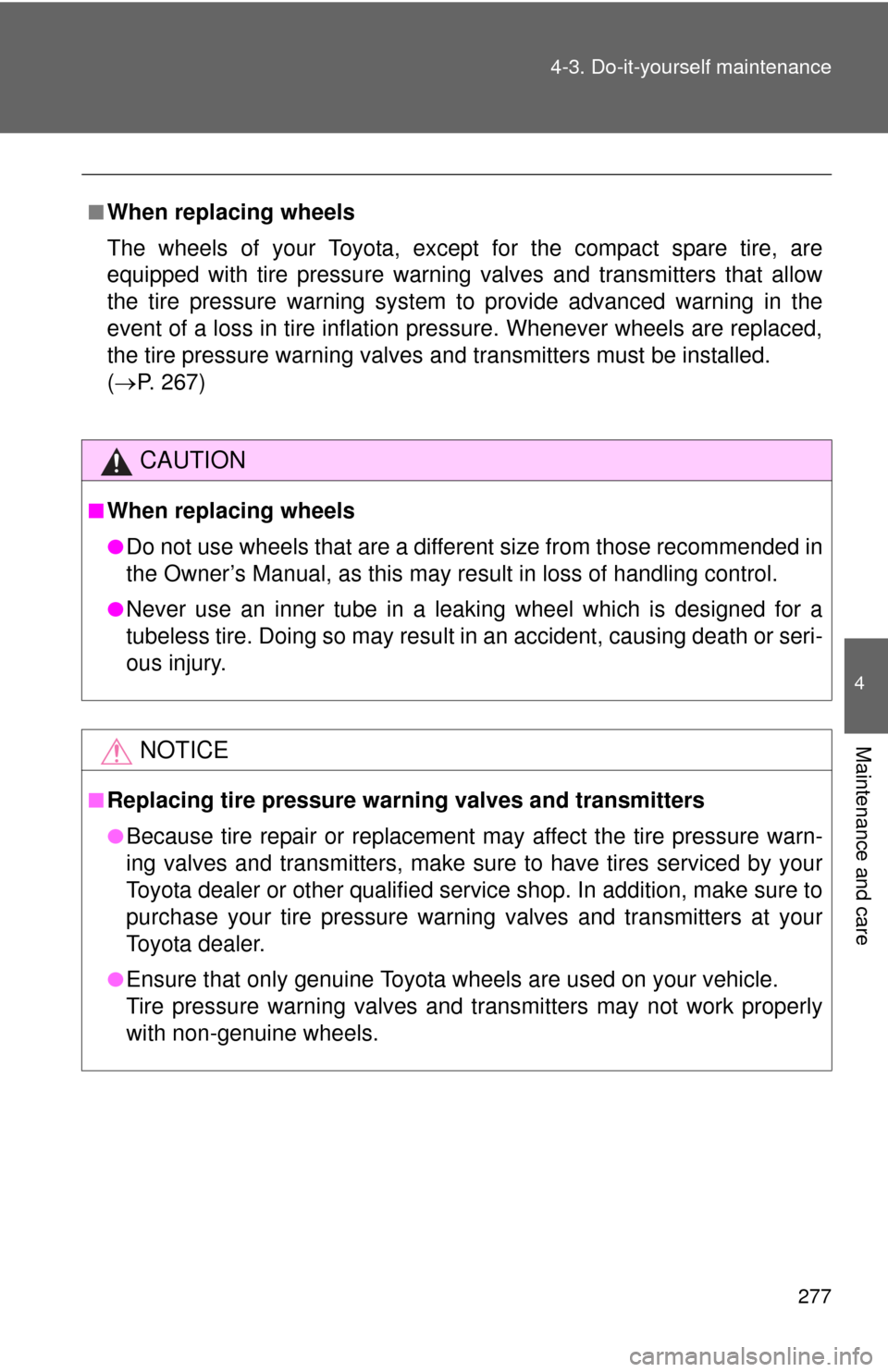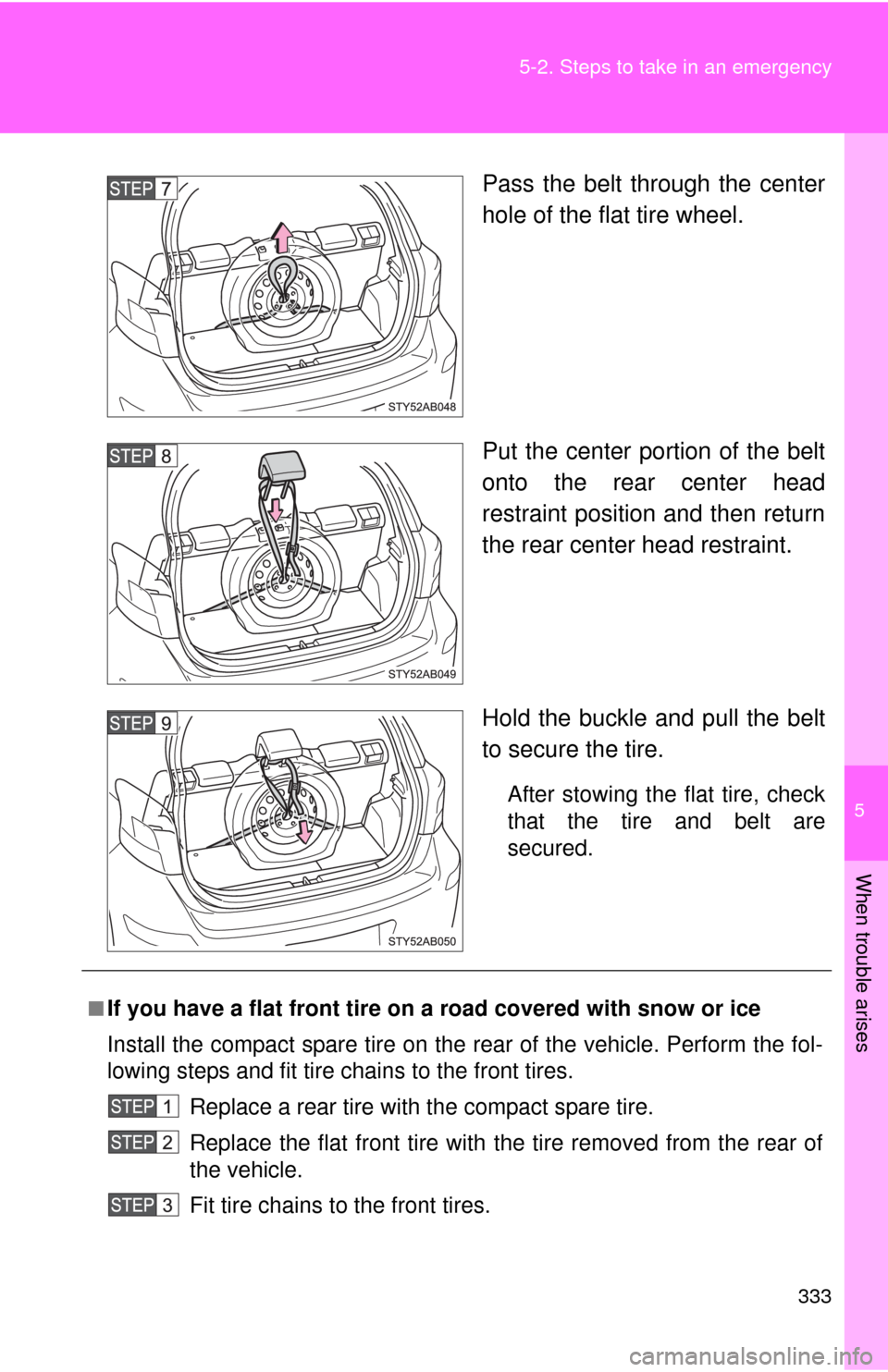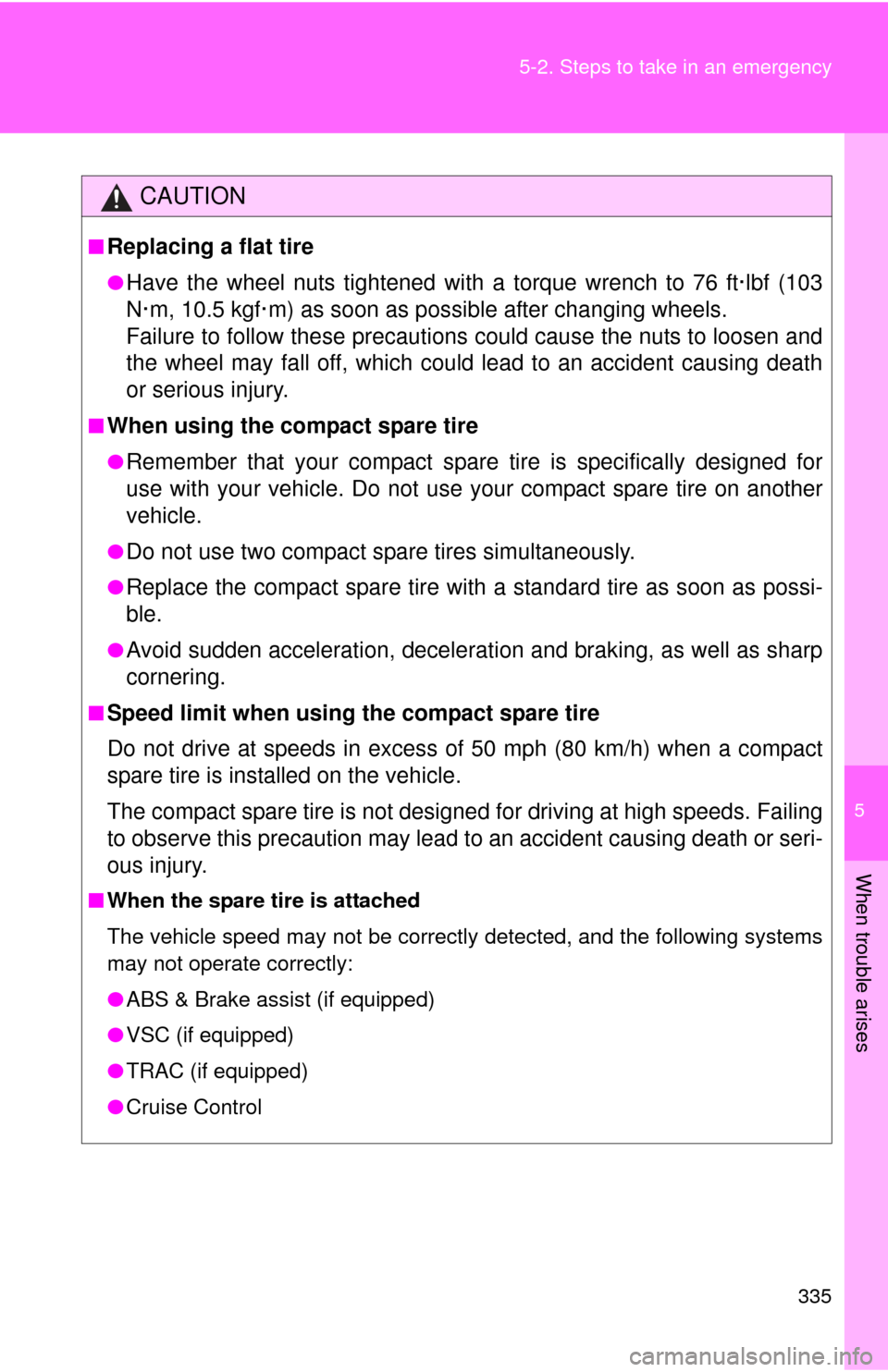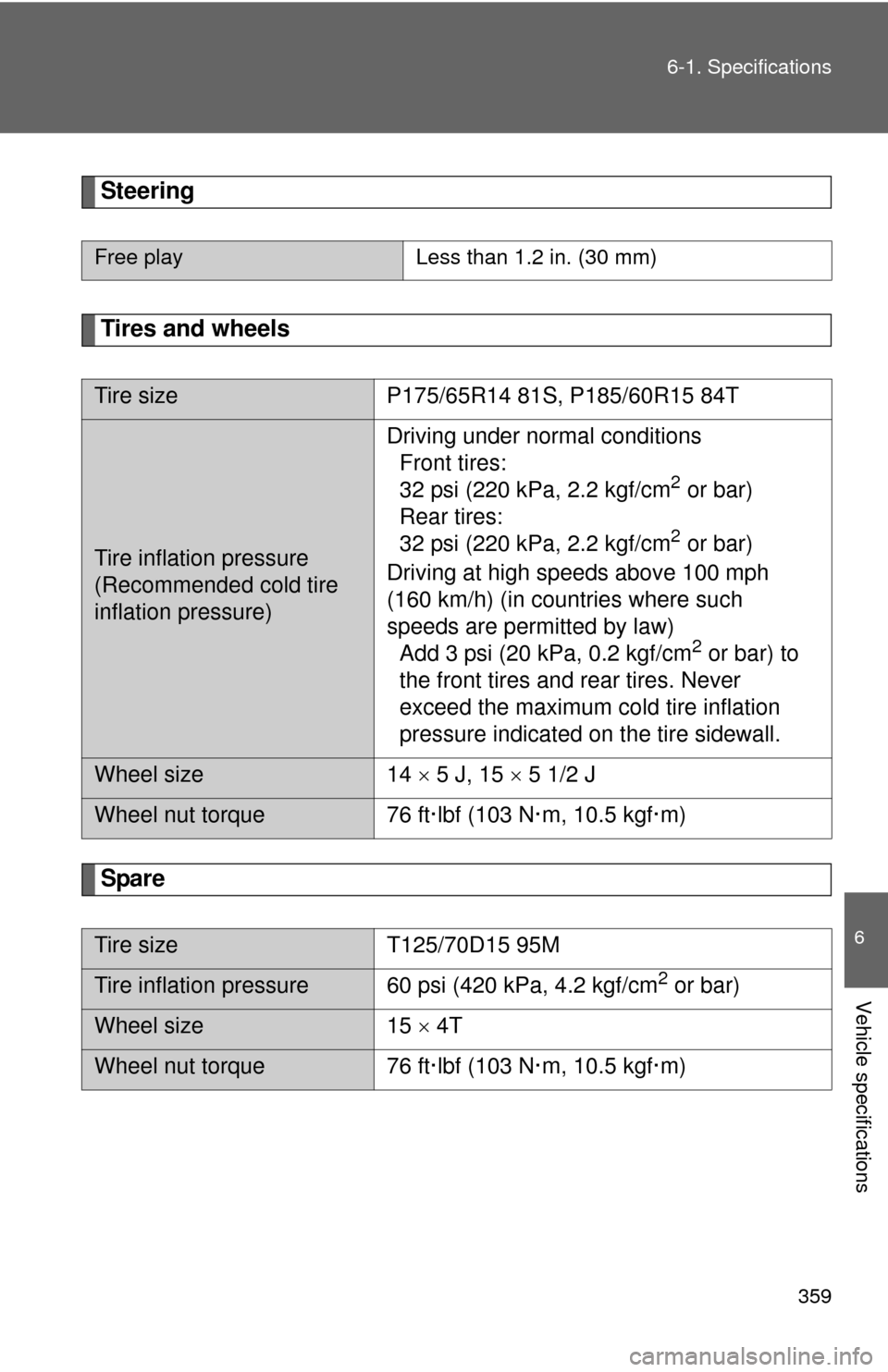2010 TOYOTA YARIS spare wheel
[x] Cancel search: spare wheelPage 277 of 400

277 4-3. Do-it-yourself maintenance
4
Maintenance and care
■When replacing wheels
The wheels of your Toyota, except for the compact spare tire, are
equipped with tire pressure warning valves and transmitters that allow
the tire pressure warning system to provide advanced warning in the
event of a loss in tire inflation pressure. Whenever wheels are replaced,
the tire pressure warning valves and transmitters must be installed.
(P. 267)
CAUTION
■When replacing wheels
●Do not use wheels that are a different size from those recommended in
the Owner’s Manual, as this may result in loss of handling control.
●Never use an inner tube in a leaking wheel which is designed for a
tubeless tire. Doing so may result in an accident, causing death or seri-
ous injury.
NOTICE
■Replacing tire pressure warning valves and transmitters
●Because tire repair or replacement may affect the tire pressure warn-
ing valves and transmitters, make sure to have tires serviced by your
Toyota dealer or other qualified service shop. In addition, make sure to
purchase your tire pressure warning valves and transmitters at your
Toyota dealer.
●Ensure that only genuine Toyota wheels are used on your vehicle.
Tire pressure warning valves and transmitters may not work properly
with non-genuine wheels.
Page 322 of 400

322 5-2. Steps to take in an emergency
■Customization that can be configured at Toyota dealer
●The vehicle speed linked seat belt reminder buzzer can be disabled.
(Customizable features P. 377)
●The key reminder buzzer can be disabled.
(Customizable features P. 377)
●The light reminder buzzer can be disabled.
(Customizable features P. 377)
CAUTION
■If the tire pressure warning light comes on
Be sure to observe the following precautions. Failure to do so could
cause loss of vehicle control and result in death or serious injury.
●Stop your vehicle in a safe place as soon as possible. Adjust the tire
inflation pressure immediately.
●If the tire pressure warning light comes on even after tire inflation pres-
sure adjustment, it is probable that you have a flat tire. Check the tires.
If the tire is flat, change to the spare tire and have the flat tire repaired
by the nearest Toyota dealer.
●Avoid abrupt maneuvering and braking. If the vehicle tires deteriorate,
you could lose control of the steering wheel or the brakes.
■If a blowout or sudden air leakage should occur
The tire pressure warning system may not activate immediately.
■Maintenance of the tire
Each tire, including the spare (if provided), should be checked monthly
when cold and inflated to the inflation pressure recommended by the
vehicle manufacturer on the vehicle placard or tire inflation pressure
label (tire and load information label). (If your vehicle has tires of a differ-
ent size than the size indicated on the vehicle placard or tire inflation
pressure label [tire and load information label], you should determine the
proper tire inflation pressure for those tires.)
Page 333 of 400

5
When trouble arises
333 5-2. Steps to take in an emergency
Pass the belt through the center
hole of the flat tire wheel.
Put the center portion of the belt
onto the rear center head
restraint position and then return
the rear center head restraint.
Hold the buckle and pull the belt
to secure the tire.
After stowing the flat tire, check
that the tire and belt are
secured.
■If you have a flat front tire on a road covered with snow or ice
Install the compact spare tire on the rear of the vehicle. Perform the fol-
lowing steps and fit tire chains to the front tires.
Replace a rear tire with the compact spare tire.
Replace the flat front tire with the tire removed from the rear of
the vehicle.
Fit tire chains to the front tires.
Page 335 of 400

5
When trouble arises
335 5-2. Steps to take in an emergency
CAUTION
■Replacing a flat tire
●Have the wheel nuts tightened with a torque wrench to 76 ft·lbf (103
N·m, 10.5 kgf·m) as soon as possible after changing wheels.
Failure to follow these precautions could cause the nuts to loosen and
the wheel may fall off, which could lead to an accident causing death
or serious injury.
■When using the compact spare tire
●Remember that your compact spare tire is specifically designed for
use with your vehicle. Do not use your compact spare tire on another
vehicle.
●Do not use two compact spare tires simultaneously.
●Replace the compact spare tire with a standard tire as soon as possi-
ble.
●Avoid sudden acceleration, deceleration and braking, as well as sharp
cornering.
■Speed limit when using the compact spare tire
Do not drive at speeds in excess of 50 mph (80 km/h) when a compact
spare tire is installed on the vehicle.
The compact spare tire is not designed for driving at high speeds. Failing
to observe this precaution may lead to an accident causing death or seri-
ous injury.
■When the spare tire is attached
The vehicle speed may not be correctly detected, and the following systems
may not operate correctly:
●ABS & Brake assist (if equipped)
●VSC (if equipped)
●TRAC (if equipped)
●Cruise Control
Page 336 of 400

336 5-2. Steps to take in an emergency
NOTICE
■Do not drive the vehicle with a flat tire.
Do not continue driving with a flat tire.
Driving even a short distance with a flat tire can damage the tire and the
wheel beyond repair.
■Be careful when driving over bumps with the compact spare tire
installed on the vehicle.
The vehicle becomes lower when driving with the compact spare tire
compared to when driving with standard tires. Be careful when driving
over uneven road surfaces.
■Driving with tire chains and the compact spare tire
Do not fit tire chains to the compact spare tire.
Tire chains may damage the vehicle body and adversely affect driving
performance.
■When replacing the tires
●When removing or fitting the wheels, tires or the tire pressure warning
valve and transmitter, contact your Toyota dealer as the tire pressure
warning valve and transmitter may be damaged if not handled cor-
rectly.
●Replace the grommets for the tire pressure warning valves and trans-
mitters as well.
■To avoid damaging the tire pressure warning valves and transmit-
ters
Do not use liquid sealants on flat tires.
Page 359 of 400

359 6-1. Specifications
6
Vehicle specifications
Steering
Tires and wheels
Spare
Free play Less than 1.2 in. (30 mm)
Tire size P175/65R14 81S, P185/60R15 84T
Tire inflation pressure
(Recommended cold tire
inflation pressure)Driving under normal conditions
Front tires:
32 psi (220 kPa, 2.2 kgf/cm
2 or bar)
Rear tires:
32 psi (220 kPa, 2.2 kgf/cm
2 or bar)
Driving at high speeds above 100 mph
(160 km/h) (in countries where such
speeds are permitted by law)
Add 3 psi (20 kPa, 0.2 kgf/cm
2 or bar) to
the front tires and rear tires. Never
exceed the maximum cold tire inflation
pressure indicated on the tire sidewall.
Wheel size 14 5 J, 15 5 1/2 J
Wheel nut torque 76 ft·lbf (103 N·m, 10.5 kgf·m)
Tire size T125/70D15 95M
Tire inflation pressure 60 psi (420 kPa, 4.2 kgf/cm2 or bar)
Wheel size 15 4T
Wheel nut torque 76 ft·lbf (103 N·m, 10.5 kgf·m)
Page 394 of 400

394 Alphabetical index
Seat belts
Adjustment ..............................57
ALR .........................................61
Automatic Locking Retractor ...61
Child restraint system
installation ................... 102, 106
Cleaning and maintaining...... 240
Comfort guide..........................59
ELR .........................................61
Emergency Locking
Retractor .............................. 61
How to wear your seat belt......56
How your child should wear
the seat belt ..........................62
Pregnant women, proper seat
belt use .................................62
Reminder light ....................... 318
Seat belt extenders .................62
Seat belt pretensioners ...........61
Seats
Adjustment ..............................40
Adjustment precautions........... 42
Child seats/child restraint
system installation ...... 102, 106
Cleaning ................................ 238
Folding down the rear seat......45
Folding down the rear seat
precautions ...........................49
Front seat adjustment .............40
Front seat adjustment
precautions ...........................42
Head restraint..........................50
Properly sitting in the seat .......83
Service reminder
indicators .............................. 145
Shift lever
Automatic transmission ......... 132
If the shift lever cannot be
shifted from P...................... 339
Manual transmission ............. 134
Shift lock system..................... 339
Side airbags................................85Side marker lights
Replacing light bulbs ............. 294
Switch ................................... 149
Wattage................................. 360
Side mirror
Adjusting ................................. 68
Defogger ............................... 193
Folding .................................... 69
Spare tire
Identification number............. 364
Inflation pressure .......... 272, 359
Information ............................ 364
Replacing .............................. 325
Size ....................................... 359
Storage location .................... 325
Spark plug ................................ 356
Specifications .......................... 352
Speedometer ............................ 139
Steering wheel
Adjustment .............................. 66
Column lock release ............. 130
Electric power steering.......... 160
EPS ....................................... 160
Specification.......................... 359
Warning light ......................... 316
Stop lights
Replacing light bulbs ............. 294
Wattage................................. 360
Storage features
Auxiliary boxes .............. 220, 225
Bottle holders ................ 220, 223
Cup holders................... 220, 222
Glove boxes .................. 220, 221
Storage precautions ................ 167
Stuck
If the vehicle becomes
stuck ................................... 348
Sun visors ................................ 227
Switch
Cruise control ........................ 156
Emergency flashers
switch.................................. 304
Engine switch ........................ 129S